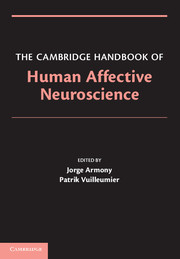Crossref Citations
This Book has been
cited by the following publications. This list is generated based on data provided by Crossref.
Lotz, Aïleen
2011.
An Economic Approach to the Self: The Dual Agent.
SSRN Electronic Journal,
Hogan, Patrick Colm
2014.
Literary Brains: Neuroscience, Criticism, and Theory.
Literature Compass,
Vol. 11,
Issue. 4,
p.
293.
Jarymowicz, Maria T.
and
Imbir, Kamil K.
2015.
Toward a Human Emotions Taxonomy (Based on Their Automatic vs. Reflective Origin).
Emotion Review,
Vol. 7,
Issue. 2,
p.
183.
Bülow, Morten Hillgaard
and
Holm, Marie-Louise
2016.
Queering ‘Successful Ageing’, Dementia and Alzheimer’s Research.
Body & Society,
Vol. 22,
Issue. 3,
p.
77.
Dąbrowski, Andrzej
2016.
Preface: Reflections on Emotions.
Studia Humana,
Vol. 5,
Issue. 3,
p.
3.
Easterlin, Nancy
2017.
The Palgrave Handbook of Affect Studies and Textual Criticism.
p.
827.
Aimar, Thierry
2017.
La neuroéconomie : quelques éclairages sur un nouveau genre disciplinaire.
L'Actualité économique,
Vol. 92,
Issue. 1-2,
p.
435.
Kosonogov, Vladimir
De Zorzi, Lucas
Honoré, Jacques
Martínez-Velázquez, Eduardo S.
Nandrino, Jean-Louis
Martinez-Selva, José M.
Sequeira, Henrique
and
Urgesi, Cosimo
2017.
Facial thermal variations: A new marker of emotional arousal.
PLOS ONE,
Vol. 12,
Issue. 9,
p.
e0183592.
Mayor, Claire
and
Sander, David
2018.
13 cas cliniques en neuropsychologie des émotions.
p.
331.
Wang, Chen
Pun, Thierry
and
Chanel, Guillaume
2018.
A Comparative Survey of Methods for Remote Heart Rate Detection From Frontal Face Videos.
Frontiers in Bioengineering and Biotechnology,
Vol. 6,
Issue. ,
Sander, David
Grandjean, Didier
and
Scherer, Klaus R.
2018.
An Appraisal-Driven Componential Approach to the Emotional Brain.
Emotion Review,
Vol. 10,
Issue. 3,
p.
219.
Fasso, Wendy
and
Knight, Bruce Allen
2018.
Innovative Applications of Online Pedagogy and Course Design.
p.
128.
von Scheve, Christian
2018.
The Palgrave Handbook of Biology and Society.
p.
391.
Kim, Byung Hyung
and
Jo, Sungho
2018.
Deep Physiological Affect Network for the Recognition of Human Emotions.
IEEE Transactions on Affective Computing,
p.
1.
Garcés, Mario
and
Finkel, Lucila
2019.
Emotional Theory of Rationality.
Frontiers in Integrative Neuroscience,
Vol. 13,
Issue. ,
Pedersen, Inge
Bonde, Lars
Hannibal, Niels
Nielsen, Jimmy
Aagaard, Jørgen
Bertelsen, Lars
Jensen, Silvia
and
Nielsen, René
2019.
Music Therapy as Treatment of Negative Symptoms for Adult Patients Diagnosed with Schizophrenia—Study Protocol for a Randomized, Controlled and Blinded Study.
Medicines,
Vol. 6,
Issue. 2,
p.
46.
Dąbrowski, Andrzej
2019.
Źródła, natura i funkcje emocji. Studium teorii impulsji Leona Petrażyckiego w kontekście współczesnych badań.
Rymarczyk, Krystyna
Żurawski, Łukasz
Jankowiak-Siuda, Kamila
and
Szatkowska, Iwona
2019.
Empathy in Facial Mimicry of Fear and Disgust: Simultaneous EMG-fMRI Recordings During Observation of Static and Dynamic Facial Expressions.
Frontiers in Psychology,
Vol. 10,
Issue. ,
Leiva, Samanta
Margulis, Laura
Micciulli, Andrea
and
Ferreres, Aldo
2019.
Dissociation between facial and bodily expressions in emotion recognition: A case study.
The Clinical Neuropsychologist,
Vol. 33,
Issue. 1,
p.
166.
Tavakoli, Arash
Boukhechba, Mehdi
and
Heydarian, Arsalan
2020.
Advances in Human Aspects of Transportation.
Vol. 1212,
Issue. ,
p.
32.





